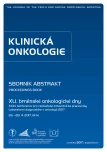Zinc-modified Nanotransporter for Target Drug Therapy of Breast Cancer
Authors:
S. Skaličková 1; M. Gargulák 2; M. Löffelmann 2; B. Ruttkay-Nedecký 2; M. Kepinská 3; T. Parák 1; Kizek R. 1–3
Authors‘ workplace:
Ústav humánní farmakologie a toxikologie, Farmaceutická fakulta, Veterinární a farmaceutická univerzita Brno
1; Centrální laboratoře, Farmaceutická fakulta, Veterinární a farmaceutická univerzita Brno
2; Ústav biomedicínských a environmentálních analýz, Wroclaw Medical University, Wroclaw, Polsko
3
Published in:
Klin Onkol 2017; 30(Supplementum1): 174-176
Category:
Article
Overview
Background:
In the centre of nanomedical interest stands the nanotechnological modification of anthracycline antibiotics, which are often used in antitumor treatment of hematological malignancies and solid tumors. Chitosan nanoparticles are gaining more attention in the field of targeted transport of drugs because of their stability, low toxicity and simple preparation. The main objective of the project, was the design of chitosan nanotransporter of anthracycline antibiotics with zinc modified surface, for a specific interaction with metallothionein.
Material and Methods:
The chitosan nanoparticles with encapsulated doxorubicin were prepared by a dissolution of 5 g of chitosan in 3% solution of acetic acid and TPP (0.25% w/v) and doxorubicin (0.5 mg/ml). Fe2O3-NPs were prepared by a reduction with borohydride and using ammonia. Thereafter Fe2O3-AuNPs were prepared by thermal synthesis. The amount of doxorubicin and Zn2+ was determined using DPV.
Results:
Chitosan nanotransporter with anthracycline antibiotics (CHIT-Zn-DOXO-Fe2O3-AuNPs) was designed and subsequently studied by biophysical methods. Inside of the nanometric structure is electrostatically bound doxorubicin (concentration 10 µM, CHIT-DOXO). Moreover metallothionein is a molecule rich in cysteine and thanks to its free sulphhydryl groups is capable of bonding with the zinc ions. We have decided to use this ability for a construction of the nanotransporter for its targeted direction towards the tumor tissue (CHIT-Zn-DOXO). We have shown significant increases of a metallothionein (MT) level in malignant tumors in many of our previous experiments. MT into its domains binds heavy metal ions (naturally zinc ions) and keeps the homeostasis in equilibrium this way. Therefore we have decided to observe the ability of modified chitosan nanoparticles (CHIT-Zn-DOXO, 100 µg/ml) for MT protein binding (magnetic gold nanoparticles were modified by MT, 100 µg/ml, Fe2O3-AuNPs) in the other part of our experiment. The efficiency of the chitosan nanoparticle bond modified by zinc ions (CHIT-Zn-DOXO) to the MT (CHIT-Zn-DOXO-Fe2O3-AuNPs-MT) increased by more than 30% compared with the unmodified nanoparticle (CHIT-DOXO).
Conclusion:
We assume that the new nanotransporter is specific for its bioavailability, increased uptake of the drug from bloodstream in the tumor tissue area and low toxicity for an untargeted tissue.
Key words:
chitosan – magnetic gold nanoparticles – breast cancer – doxorubicin
The work was realized with the support of the project NANODRUGS 328/2017/FaF and The European Technology Platform for Nanomedicine.
The authors declare they have no potential conflicts of interest concerning drugs, products, or services used in the study.
The Editorial Board declares that the manuscript met the ICMJE recommendation for biomedical papers.
Submitted:
6. 3. 2017
Accepted:
26. 3. 2017
Sources
1. Shi JJ, Kantoff PW, Wooster R et al. Cancer nanomedicine: progress, challenges and opportunities. Nat Rev Cancer 2017; 17 (1): 20–37. doi: 10.1038/nrc.2016.108.
2. Yaari Z, da Silva D, Zinger A et al. Theranostic barcoded nanoparticles for personalized cancer medicine. Nat Commun 2016; 7: 13325. doi: 10.1038/ncomms13325.
3. Kamaly N, He JC, Ausiello DA et al. Nanomedicines for renal disease: current status and future applications. Nat Rev Nephrol 2016; 12 (12): 738–753. doi: 10.1038/ nrneph.2016.156.
4. Zhao HY, Lv P, Huo D et al. Doxorubicin loaded chitosan-ZnO hybrid nanospheres combining cell imaging and cancer therapy. RSC Adv 2015; 5 (74): 60549–60551.
5. Esmaeili A, Hadad NA. Preparation of ZnFe2O4-chitosan-doxorubicin hydrochloride nanoparticles and investigation of their hyperthermic heat-generating characteristics. Ceram Int 2015; 41 (6): 7529–7535.
6. Gomulkiewicz A, Jablonska K, Pula B et al. Expression of metallothionein 3 in ductal breast cancer. Int J Oncol 2016; 49 (6): 2487–2497. doi: 10.3892/ijo.2016.3759.
7. Burton C, Dan YB, Donovan A et al. Urinary metallomics as a novel biomarker discovery platform: breast cancer as a case study. Clin Chim Acta 2016; 452: 142–148. doi: 10.1016/j.cca.2015.11.014.
8. Chandler P, Kochupurakkal BS, Alam S et al. Subtype-specific accumulation of intracellular zinc pools is associated with the malignant phenotype in breast cancer. Mol Cancer 2016; 15: 2. doi: 10.1186/s12943-015-0486-y.
9. Gumulec J, Masarik M, Adam V et al. Serum and tissue zinc in epithelial malignancies: a meta-analysis. PLoS One 2014; 9 (6): e99790. doi: 10.1371/journal.pone.0099790.
10. Gumulec J, Raudenska M, Adam V et al. Metallothionein – immunohistochemical cancer biomarker: a meta-analysis. PLoS One 2014; 9 (1): e85346. doi: 10.1371/journal.pone.0085346.
11. Adam V, Petrlova J, Wang J et al. Zeptomole electrochemical detection of metallothioneins. PLoS One 2010; 5 (7): e11441. doi: 10.1371/journal.pone.0011441.
Labels
Paediatric clinical oncology Surgery Clinical oncologyArticle was published in
Clinical Oncology

2017 Issue Supplementum1
- Metamizole vs. Tramadol in Postoperative Analgesia
- Metamizole at a Glance and in Practice – Effective Non-Opioid Analgesic for All Ages
- Possibilities of Using Metamizole in the Treatment of Acute Primary Headaches
- Current Insights into the Antispasmodic and Analgesic Effects of Metamizole on the Gastrointestinal Tract
- Spasmolytic Effect of Metamizole
Most read in this issue
- Ascites May Provide Useful Information for Diagnosis of Ovarian Cancer
- Lactate Dehydrogenase – Old Tumour Marker in the Light of Current Knowledge and Preanalytic Conditions
- Molecular Pathology of Colorectal Cancer, Microsatellite Instability – the Detection, the Relationship to the Pathophysiology and Prognosis
- Circulating Myeloid Suppressor Cells and Their Role in Tumour Immunology
